Louisa Hodges' Ancestors |
Click on a name for info, click on an arrow to follow that branch, click Home to go to the main page, or click for an Alphabetic List of all Names. |
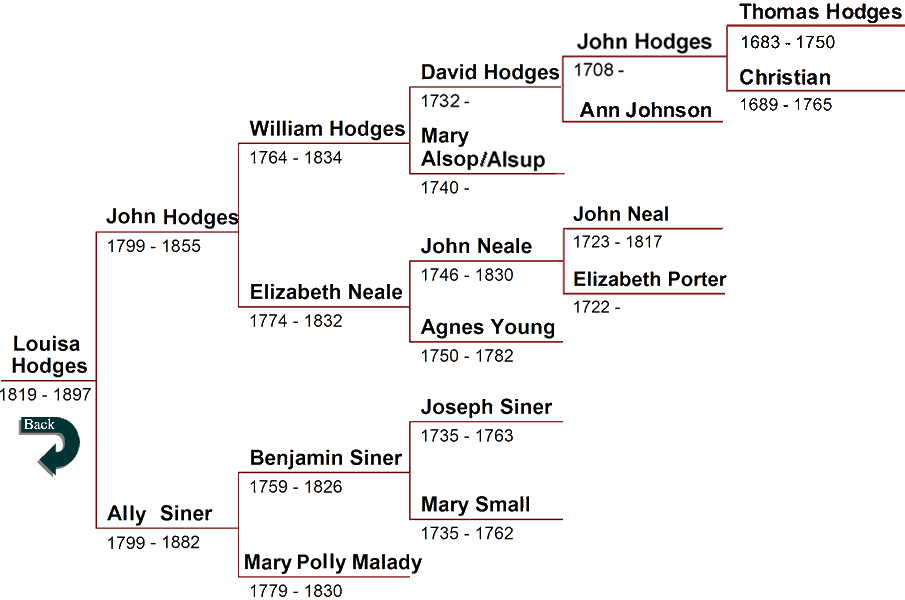
|
|
John Hodges was born on February 2, 1799 in Harrison County, Kentucky. John Adams was president and Kentucky had been a state for seven years. He was the first of eight children born to William Hodges, 35 and Elizabeth Neale, 25 years-old. John married Allie Siner on October 6, 1818, in Ohio County, Kentucky, and there they had the first of at least nine children, ancestor Louisa, on September 8, 1819, when he was 20 years old. The 1820 census, dated August 7, 1820, has them living in Boone County, Kentucky. Between this date and June of 1821, they moved to Indiana. James Monroe was president and Indiana had just become a state in 1816. Their remaining children were — James born on August 3, 1821, who died at age 4; Hardin born on April 26, 1824; Sarah Ellen Sallie born on January 13, in 1827; Cynthia born in 1829 who married the great grandson of ancestor William Kester and his second wife; Caroline was born in November of 1832; Mary Ann in 1835; William on January 5, 1837, who died at 22 months old; and John Malady born on May 22, 1839, who drowned in 1858, at 19 years old while working to build the Wabash Canal at Terre Haute.
The Vigo County probate records include a few cases where John was assigned guardianship of underaged children. On May 20, 1833, John posted a $400 bond as guardian for the seven minor children of Benjamin Stark. Six months later on November 18th, he posted an additional $600 bond for the same guardianship. On November 17, 1834, with a $100 bond, he became guardian for eight underaged children of Isaac Roll, deceased. That same day he petitioned the court to sell real estate in the children’s names, paying an additional $600 bond. He promised to “faithfully apply the money from such sale under the direction of the court and shall render an account therefore according to law . . .” On February 20, 1837, John posted a $1,000 bond for the guardianship of Elijah and Willis Pierson. Four years later on August 26, 1841, John posted an additional bond of $600 for the guardianship of Willis Pierson, child of Willis Pierson deceased. On March 14, 1835, the Union Baptist Church records state “Brother John Hodges Requested to withdraw his membership from the Church. The Church granted his Request.” John must have done well, as in 1839, he purchased land twice. On June 15, 1839, John buys the east half of the northeast quarter of Section 13, Township 10, north of Range 9 plus 5 acres in a Square in the southeast quarter and corner of Section 12, that seems to be a house from Joseph T., his wife Sarah Liston, and Oliver P. Liston for $400. Two weeks later, on July 1, 1839, John buys almost 35 acres of land for $300 in the southwest quarter of Section 7, Township 10, north of Range 8, from his brother-in-law James Siner and his wife Matilda. In 1839 John was one of 14 men chosen to represent Vigo County at a Cumberland road convention that was held at Terre Haute. By June 1, 1840, the date of the 1840 census, the Hodges family was living in Pierson Township, Vigo County, Indiana. John’s name reappears in the Union Baptist Church records in April of 1843, with “Brother John Hodges Cordially Restored to his Seat,” but the last mention of John in these records is in July of 1843, when he was appointed to bear our Letter to the association. His name is not mentioned again.
|
| ~< Back to Chart >~ |
Ally Allie Siner was born on September 11, 1799, (as recorded in her mother’s bible, although her gravestone says 1801) in Bedford County, Virginia. She was the second of eleven children born to Benjamin Siner and Mary Polly Malady. Her name is recorded as Ally in her mother’s bible, but sometimes it is written as Allie. By June of 1821, they were living in Indiana, probably in Sullivan County, as John was a founding member of the Little Flock Baptist Church in Shelburn. Ally’s name is not in the early Little Flock Church records, so it is possibly she may not have been a member of that church, although her parents and brother were members. On July 2, 1825, the records of the Union Baptist Church in Terra Haute, Vigo County, states that “Ally Hodges Received by Experience.” This means she was baptized in another church, but didn’t transfer her membership by letter. She joined this church six months after her husband joined, which could mean she was not living in Indiana the entire time. There is no other mention of her in Union Baptist Church records. In 1856, her husband died and she was left with one minor son, John M. Ally and her son-in-law John C. Kester, were given guardianship of him on May 21st of that year. The August 11, 1870 US Census lists farmer Hardy Hill age 75 and his wife Allie, age 67, living in the town of Sullivan in Hamilton Township, Sullivan County, Indiana. Six years later, Allie's second husband Hardy died. On the 1880 census dated June 17 and 18th, she is living with her daughter, Caroline Shelp’s family in Lost Creek, Vigo County, Indiana. Ally Siner Hodges Hill outlived two husbands and six of her children. She died on May 19, 1882 and is buried in Mount Pleasant Cemetery in Terre Haute, Vigo County, Indiana. (Mouse over photo to read her inscription.) Her gravestone lists her as Allie Hill and is shared with her daughter and son-in-law Sarah and George Sparks. |
| ~<^>~ |
William Hodges was born on April 5, 1764 in Goochland, Virginia. He was the child of David Hodges and Mary Alsop. His birth and baptism are recorded in The Douglas Register on page 213, under the chapter titled Births and Baptisms as follows “David Hoges & Mary Alsop a son named William born Ap: 5 1764. Baptized Aug: 5.” This book is a William was 11 when the Revolutionary War began. When he was 33 he married Elizabeth Neale on November 23, 1797 in Harrison County, Kentucky. They had their first two children there – ancestor John William in 1799 and Benjamin in 1800. Prior to the 1820 census dated August 7, 1820, they moved to Burlington Township, Boone County, Kentucky where they had their remaining children –William on March 9, 1802, Matthew in 1805, Sarah in 1807, Thomas on October 17, 1809, Andrew on July 20, 1812 and The records of the East Bend Baptist Church show that William Hodges represented the church in annual meetings in 1821, 1823, 1829, and 1831. The 1831 annual report says, “We note that William Hodges had been licensed to preach.” Thus he is also listed as being the preacher in 1831 on the official East Bend Baptist Church Pastors roster. William Hodges died on May 18, 1834 in Boone County at age 70, two years after his wife, Elizabeth. He was buried with Elizabeth at the East Bend Baptist Church Cemetery in Boone, Kentucky. |
| ~< Back to Chart >~ |
Prior to 1831, her father deeded 70 acres of land to her, which her family had been living on. The gift of this land was written up in her father’s will, but in a codicil he wrote on March 3, 1831, he stated that he had already deeded the land to his children. Elizabeth Neale Hodges died on April 11, 1832 in Boone County, Kentucky. She was buried there at the East Bend Baptist Church Cemetery where William was also buried two years later. (Mouse over image left to see one of the fenced in areas that make up the cemetery.) |
| ~< Back to Chart >~ |
Benjamin Siner’s ancestry is uncertain. Some researchers say he was born about 1759, in England; others say he was born in Culpeper, Virginia; still others say he was born in Middlesex, Virginia to parents Joseph Siner and Mary Small. Benjamin was said to have enlisted in the Revolutionary War at age 17 as a teamster, gunsmith and minuteman and to have been at the Battle of Bunker Hill, the taking of Cornwallis and served with Morgan. Also, as seen below, a gravestone that might be his, says that he served in General Lafayette's Continental Army. Unfortunately, there is no documentation to support any of the above information. But there is a good possibility that he is the son of Joseph and Mary (Small) Siner (see their bios below).
Benjamin married Mary, who was known as Polly, with a possible surname of Malady. In the Encyclopedia of American Quaker Genealogy, Vol VI, their marriage is listed in the Bedford County, Virginia section, under Siner as “1797, 1, 23. Benjamin [Sinor] & Polley Meridy, John Hackney, Surety.” But some researchers claim the original document is confusing and seems to be for a marriage between a John Hackney and Mary Meridy, which Benjamin signed. This researcher has not seen the original document, but sees no reason to doubt the Quaker transcription. There is also a family legend that says that Benjamin came from France via England, and he went back to near London from America to get his bride. Benjamin and Mary had eleven children, whose names and birthdates were copied from the last page of their mother’s bible. Their first five children were born in Bedford – Frances known as Fanny on November 23, 1797; ancestor Ally; Joel on September 25, 1801, who probably died in Bedford as a young child; Clemsey Ann on December 26, 1803; and James born on October 7, 1806. In the Bedford County tax records for the years 1797 thru 1806, Benjamin and John were listed consecutively most of the years. In 1804 the name James Siner appears on the tax list, but all we know of him is that he was over 16 years old. This is probably John Siner’s son who married Lucy Corley in 1808, and remained in Bedford County. By 1806, John’s other sons were listed on the tax records. Benjamin was always listed as the only white male above 16, having no black males and going from owning 1 horse in 1797 to 4 Horses, mares, colts and mules in 1806.
There are five clear Daviess County, Kentucky tax records that place Benjamin there in 1815 and 1819 to 1822 (some years are unreadable). So it is likely that son John Malady was born there on September 19, 1819. What is interesting to note is that both a James and William Sineth are living there during these years. In 1815 Benjamin’s Total Value was listed as 300 for 200 3rd Rate acres in the Panther Creek water course, in what looks like the Isaac Holmes Militia Company. In 1819, his Total Value is 100, for his 1 acre of 1st Rate Land and 3 Horses Mares. In 1820, he is listed as a Voter, doesn’t have any land, has only 2 Horses Mares, and still has a Total Value of 100. In 1821, his Total Value is 120, has 1 acre of 1st Rate Land and 3 Horses. In 1822, he is listed as a Voter, doesn’t have any land, has 3 Horses and his total value is 200. These tax records are not dated, other than by year, but all were Examined & corrected in the following year. The 1820 Census for Daviess County, has Benjamin Signer, with his wife and their seven children (Frances and Ally are now married), living there. It is likely that son Ancil was born there on September 21, 1822, and probably died there a few years later. By mid year 1823 the family had moved to Sullivan County, Indiana. Their two oldest daughters, Fanny, who had already married in Breckinridge County, Kentucky, and Ally, who had married in Ohio County, Kentucky, came along with their husbands as well. On August 7, 1823, Benjamin and Polly Siner joined the Little Flock Baptist Church there. They were received into membership by letter, meaning they transferred from another church. (Mouse over church record image left.) By 1824, Benjamin had purchased farm land near the Union Baptist Church, in Pierson Township, Vigo County, Indiana. Some researchers say they became very active in the Vigo County area and his name is documented in almost two hundred and fifty various records there. These researchers go on to say that one notable contribution that he made was to donate land for the Union Baptist Church and Cemetery. Benjamin's estate was probated on September 6, 1826 but not settled until January of 1831. His wife Polly was the administrator of his estate. The three men who did the inventory were Moses Evans, who was married to Sarah Kester, daughter of ancestors Ruhama Bonham and Paul Kester; ancestor William Welch, who was married to ancestor Rebecca Kester, sister of Sarah, previously mentioned; and Joseph Liston, who was the father-in-law to Sarah Welch, daughter of previously mentioned ancestors William Welch and Rebecca Kester. The three and a quarter page inventory of his estate was taken on September 20, 1826, and it amounted to $457.74. It was filed on March 31, 1827, and recorded a few days later on April 2nd. The guardianship of the four youngest surviving children-Hugh, Polly, Benjamin and John was given to Joseph Liston and it went on until 1850, long after these children came of age. There are 60 pieces of paper in his Probate Guardianship file and 56 papers in his Probate Estate file. You can view one of the guardianship papers above in John Hodges bio and one below in Joseph Siner's bio. |
| ~< Back to Chart >~ |
Mary Polly Malady was born about 1779, possibly in Bedford, Virginia. Her parents are not known as their last name may have been spelled Maliday, Malliday, Mallady and Meridy, which makes exact records difficult to find. It is believed her maiden name was Malady because many of her descendants were given the middle name of Malady. According to the Encyclopedia of American Quaker Genealogy, Vol VI, Mary married Benjamin Siner in Bedford County, Virginia on January 23, 1797. See Benjamin Siner above for marriage and children details. Mary kept a record of her children’s births on the last page of her New Testament Bible. Her great-grand-daughter, Maude Russell transcribed the names and dates and they were published in The Vigo County Historical Society’s Family Bible Records book in 1952.
About a year later, she married Benjamin Harris on February 7, 1828 in Vigo County, Indiana. Harris was widowed and had many children, whom she probably raised. Mary’s name on the marriage license was recorded as Polly Siner, which has caused a great deal of confusion with her eighth child from her first husband, Mary Polly Siner who married her stepbrother Benjamin Harris Jr. who was the son of Benjamin Sr. and first wife Mary Paddock Harris. On April 5, 1828, the records of the Union Baptist Church states, “Granted a Letter of Dismission to Mary Harris formerly Siner.” This proves that even though there is no record of it, Mary Siner had become a member of the Union Baptist Church, prior to her second marriage. On January 29, 1829, a command was given by the state to the Sheriff of Vigo County to summon Polly Siner to appear before the Probate Court Judges to show why she has not made a final settlement of the estate of Benjamin Siner. It is believed that Polly Siner Harris died about 1830 - before her second husband leaving him, for the second time, a widow (it is said he was widowed four times). Polly is said to be buried in Fairbanks Cemetery, also known as the Pound Cemetery (pictured right) in Sullivan County, Indiana, but a gravestone has not been found. Her second husband is buried there with a stone and there is a record of his first wife’s burial there, but again without a stone. He may have buried ancestor Polly there also, but he could have buried her with her first husband. |
| ~< Back to Chart >~ Note: Before 1752 the year began on March 25th. Dates between January 1st and March 24th were at the end of the year, not the beginning. |
David Hodges’ ancestry is uncertain. He is believed to be the third child of seven, born about 1732 in Goochland County, Virginia, to John Hodges and his first wife Ann Johnson. The uncertainty arises because their were two David Hodges in Goochland County at the time. The other David married Elizabeth Page, and was the son of Edmund, our David’s uncle. Most researchers agree that our David was the son of John and Ann. David married Mary Alsop. Their marriage date of April 5, 1764 is listed in The Douglas Register on page 108, under the chapter titled “Marriages not Recorded by Rev. William Douglas, but indicated by the Birth Registry - Male Index.” This book is a detailed record of “Births, Marriages & Deaths ... as kept by the Rev. William Douglas 1750-1797.” All references are under the name “Hoges , David & Mary Alsop.” Being that the only child on record, William, was born on April 5, 1764, the same date recorded for their marriage, they most likely were married earlier in another place. This date was probably recorded only to show that they were married when their child was born, as others have been entered in the same manner. David, with or without Mary, may have traveled with the Alsop’s, to Botetourt and then Montgomery, Virginia, and then on to Kentucky, where their son was married. Unfortunately, he may have died along the way, as we do not know when or where David Hodges died. Note that David did not sign the marriage agreement in 1797, his son William signed for himself (click on image above in Elizabeth Neale's bio). This could indicate that David was dead by then. |
| ~<^>~ |
Mary Alsop/Alsup was born in the early to mid 1740's, probably in Goochland County, Virginia. There are at least two options for her parentage. She could have been the eldest of at least five children born to parents John Alsop/Alsup and his first wife, name unknown. A more compelling possibility is that Mary was the orphaned daughter of Thomas Alsup and wife Mary. Thomas Alsup died in 1741, Goochland County, Virginia, naming his widow Mary and orphaned daughter, Mary. Mary Alsup was again named in 1746 to be bound to a Mary Lad (possibly her remarried mother). Mary Allsup was yet again named in 1763 as a witness in a freedom lawsuit by a black woman. Mary Alsop married David Hoges, in Goochland County, Virginia. Their marriage date of April 5, 1764 is documented in The Douglas Register on page 124, under the “Marriages not Recorded by Rev. William Douglas, but indicated by the Birth Registry - Female Index.” Being that the only child on record, William, was born on April 5, 1764 in Goochland, Virginia, the same date recorded for their marriage, they most likely were married, earlier, maybe in another place. She may have traveled with the Alsup family to Botetourt and than Montgomery, Virginia, and then on to Kentucky, where her son was married. Unfortunately, Mary may have died along the way, as we do not known when or where Mary Alsop Hodges died. Thanks to David, Sam and Jerry for their research and passing this information on to me! |
| ~< Back to Chart >~ |
When John Jr. was about 24, in 1770, he married a woman, who some say was Agnes Young. They had four children, all thought to be born in the Kentucky Territory – Matthew in 1770; ancestor Elizabet; William on January 22, 1776; and Benjamin in 1777. (William on the 1850 and 1860 census states he was born in Virginia.)
John and Agnes purchased 304 acres of land for five shillings on July 29, 1808 in the East Bend area in Boone County, where the Ohio River bends and flows to the east. The family attended the Bullittsburg Baptist Church, the first Baptist church in what is now known as Boone County, Kentucky. In 1803, the Middle Creek Baptist Church was formed and they attended it. In 1819, a group in this East Bend neighborhood decided they would like to have a church in their own community. On Saturday, January 2, 1820, John and second wife Agnes along with his son William and wife Nancy Neal, a Rebecca Neal -who could be John Jr’s second wife, and ancestors William and Elizabeth Hodges with their sons John and Benjamin Hodges were dismissed from the Middle Creek Baptist Church to join the newly created East Bend Baptist Church. This new church was located approximately five miles south of Rabbit Hash, across the Ohio River from Rising Sun, Indiana. John Neal Sr wrote his will on April 11, 1818 and reads as follows as printed on the genealogy.com website: “WILL OF JOHN NEAL SR.: In the Name of God Amen. I John Neal of the County of Boone and State of Kentucky being in health and of perfect mind and memory but being advanced in years and calling to mind approaching mortality do make and ordain this my Last Will and Testament and first I recommend my soul to God who gave it, and my body to the earth from which it was taken to be buried in a decent and Christian like manner -- And as touching the worldly property wherewith I have pleased Lord to help me -- I do hereby dispose of it in the following manner in that is to say, I give and bequeath to my beloved wife Agnes Neal my whole Estate (not otherwise specially disposed of) during her natural life viz about one hundred & twenty five acres of land whereon I now live, all my household furniture, stock, farming utensils and one Negro man named Frank who at her death or mine in case I should outlive my wife is hereby emancipated and set at liberty -- and the land aforesaid at my wife's death to be equally divided between my children John Neal and Anna Ruddell and all my personal estate after the death of my wife to be equally divided between my children Benjamin Neal and Sarah Shackleford -- Also I give and bequeath to my son Matthew Neal the sum of five shillings to be raised out of my Estate. To my son William Neal I give and bequeath the tract of land on which he now resides containing about Seventy acres more or less - as surveyed and laid off my Moses Scott on the date above a plot of which has been given him -- Also I give and bequeath to my daughter Elizabeth Hodges the tract of land on which she now resides containing about Seventy acres more or less as surveyed and laid off by Moses Scott on the date above during her natural life and then to her children the heirs of her body -- And moreover I do hereby nominate constitute and appoint my son William Neal sole Executor of this my last will and Testament -- In Testimony whereof I have hereunto set my hand and seal this 11th day of April in the year of our Lord 1818. On March 3, 1831 John added a codicil to the will voiding out the land bequests because he had already deeded the land to his children as laid out in his will. John Neale died in Boone, Kentucky, shortly after this codicil was processed, as the will with codicil was probated in June of 1831. His second wife, Agnes Midkiff Neale died on April 18, 1848, and is buried with him in the East Bend Baptist Church Cemetery in Boone, Kentucky. |
| ~< Back to Chart >~ |
Agnes Young is believed to be the name of John Neal’s first wife. Some researchers say she was born about 1750 in the territory of Kentucky to unknown parents. See John Neal above for marriage and children. Some researchers believe that Agnes Young Neale died at 32 years old in 1782, probably in the Kentucky Territory of Virginia. Nothing more is known about her. |
| ~<^>~ |
Joseph Siner’s ancesty is uncertain. Some researchers say he was born about 1735 in Virginia to parents unknown. Others say he was the Joseph Senar, baptized on August 19, 1718, in Wragby, Yorkshire, England, the son of John Senar. This researcher believes the 1718 birth makes sens. Joseph Sineth married Mrs. Mary Small, on October 31, 1750, in Middlesex County, Virginia. It is believed that the Siner’s had at least five sons — John was born on October 12, 1751, in Middlesex County; William is said to have been born there about 1753; George was also said to have been born in Middlesex about 1756, but could have been born in England; James, who is believed to have been born in Surry, England on October 1, 1758; and ancestor Benjamin. Elder son John was in the Continental Line Army in 1776, discharged on August 3, 1779. He was listed on the Company Muster and Pay Roll as John Sinath prior to July 1777 and was as John Sinah from August 1777 to August 1779. John moved to Bedford in 1797 and bought 225 ¼ acres of land with Benjamin Sinor, his brother. It is not certain that Joseph and Mary Siner are the parents of ancestor Benjamin, but they are the parents of two sons named John and Benjamin. It is believed Mary Small Siner died about 1762 and her husband Joseph died a year later in 1763, leaving their known sons orphans between the ages of twelve and four. Unfortunately, nothing more is known about them. |
| ~< Back to Chart >~ |
John Hodges was born about 1708 in Goochland County, Virginia, the second son of nine children born to Thomas and Christian Hodges. He married Ann Johnson prior to 1727 and they had at least seven children, all probably born in Goochland County – William Welcome born about 1727; Johnson born about 1730; ancestor David; Thomas about 1734; William about 1740; John Jr. about 1750; and Joseph who was probably born some time before 1754. Deed records dating from 1728 tell us that John lived in Goochland County on the north side of the James River, on the branches of Deep Creek of Licking Hole, also called Treasurers Run. On May 10, 1733, a John Hodges purchased 200 acres on the west side of Deep Creek of Licking Hole. In that same deed book, dated April 1, 1734 is a record of another 200 acres in the same area sold to William DePriest. Ann probably died shortly after her last child was born, and John married Judith DePriest (some say some say her maiden name was Austin, some say it was Randolph), who was the widow of William DePriest and a bit older than him. Some researchers say John and Judith had a son named Drury who was born about 1755 in Cumberland County, Virginia. In 1750 John inherited 200 acres of land in Cumberland County on the south branches of the Willis River from his father. He probably moved there shortly after he remarried. Before 1762, John with his brother William relocated to the northwest corner of what became Halifax County, Virginia, and settled along the banks of Bradley Creek. Other Hodges had been there for some years and were probably related to them. On January 1, 1762, John sold his inherited Cumberland County land. Unfortunately, it is not known for certain what became of John Hodges nor when and where he died. In her book Goochland County Virginia Deeds, Wills and Inventories: 1728-1826, Hodges Family, Dolores Crumrine Rutherford states that in Deed Book 20, p. 257-258 it says “Jn. Hodges’ name appears in a List of Personal Property Taxes not collectable in the Upper District of the County for 1807. Recorded 17 Oct 1808.” Many researchers believe this is when he died. Nothing more is known about his first wife and ancestor Ann Johnson. Mouse over and click on image right to enlarge. |
| ~<^>~ |
John Neal seems to be the name of the father of ancestor John Neale married to Agnes, but which John Neale it was is uncertain. One Jhn Neal was born in England to parents John O'Neal and Elizabeth Neal. A baptismal record exists for him dated August 11, 1723 at Bywell-St. Peter's Church in Northumberland, England. It lists his parents as John and Elizabeth Neal. A marriage record exists for a Jn Neall marrying Eliz Porter on October 20, 1740 in Riseley, Bedford, England. They immigrated to America before 1746 and many researchers believe this John Neal who married Elizabeth Porter are ancestors. Some researchers say the ancestors are John Owen Neale/Neel and wife Dorcas Michael. They came to America and settled in Lancaster County, Pennsylvania in 1729. (There were several John Neals in the Lancaster area. One died in 1817 in Martic, Lancaster County, Pennsylvania, who some researchers say is the ancestor.) John Owen Neel moved with seven of his children to Potts Creek, Botetourt County, Virginia, in 1780, which was fifteen years after his wife Dorcas Michael Neel died in 1765. About ten years later, in 1790, they moved to Gap Valley, Greenbrier County in Virginia, which became Monroe County in 1799 and where a large group of Neels settled. Some researchers trace John Neal's ancestry back to 1369 in Northern Ireland, including famous clan leaders in the line. This, however, is unproven. Because of this conflicting data, much more research needs to be done on this line. |
| ~< Back to Chart >~ |
Thomas Hodges was born on January 1, 1683 in Virginia, the first Hodges ancestor, that we know of, to be born in America. Unfortunately his parents are unknown. Some researchers claim he is the son of William or Thomas Hodges, both are said to have had a wife named Charity Ramsey. In the book Hodges Family History, by the American Genealogical Research Institute, it states that many Hodges came to Virginia, including one or more Robert Hodges in 1636, 1637, 1638 and 1664; one or more William Hodges in 1636 and 1639 and one William who came to Virginia “around mid-seventeenth century.” The website Pilgrim Ship Lists Early 1600's, list other Hodges who came to Virginia: a 17 year old name Jo in July of 1635; a 37 year old John in 1634/5; and a Thomas in 1635. Any one of these could have been a father or grandfather of ancestor Thomas. Orval Lee Hodges tells us that his research has show that the Hodges were blacksmiths, millwrights and farmers. T Thomas wrote his will in Cumberland County on November 6, 1749. In it he mentions “my two sons William Hodges and John Hodges, my son Drury Hodges, my son Thomas Hodges, my son Edm'd Hodges, my daughter Mary Hodges, my daughter Delany ----es.” He names his “loving wife Christian. After her natural life all his other personal estate to be equally divided among my seven Chil --- (dren).” He left 200 acres each to his sons William and ancestor John; 150 acres and “the plantation whereon I live” to his son Drury; his sons Thomas and Edmund were each left three cows and calves after the death of his wife Christian; to his daughter Mary, six hogs and six calves. His last bequest was to a son whose name began with the letter J and whose identity we may never know because that part of the page in the will has been torn off and lost. His wife Christian was appointed his sole executor. The will was signed and witnessed by Henry Bell, John Chafin (his mark), and William Mills (his mark). In a discussion of the Hodges Families Company paper titled Hodges Families of VA; James River Area 1703-1750 Henrico; Goochland; Cumberland; to Halifax, Pittsylvania, Diana Flynn writes on the Hodges-L Archives website that the paper says: “There are two ways of interpreting this will. One is that Thomas Hodges, in his will, bequeathed to his sons beginning with the first born and ending with the last born, and then to his daughters in the same order i.e. WILLIAM, JOHN, DRURY, THOMAS, EDMUND, son ‘J’ and MARY. That was the usual way of providing for children when all of them were still at home. In situations where some of the older children (male and female) had become adults and had been ‘provided for’ to some extent before the father prepared his will, then it was not unusual for the father to bequeath first to the children still at home, and then to those who had already received a large part of the support he felt was due them. If Thomas Hodges followed that pattern when he prepared his will in 1749 then we would interpret his bequests as indicating that THOMAS JR., EDMUND, MARY and son ‘J’ were grown and in large measure already provided for at the time that Thomas Sr. was preparing his will, while sons WILLIAM, JOHN and DRURY were still living at home.” The will was presented in Court, in March of 1750 by Christian and was proved. So it is seems that Thomas died sometime between the date he wrote the will and the date it was probated, March of 1750. |
| ~<^>~ |
Christian’s surname is unknown, so her ancestry is a mystery. Some researchers claim her name was Christiana Woodson, but this is not documented. It is believed she was born about 1689 in Goochland County, Virginia. She married Thomas Hodges about 1705 and had at least seven children, all born in Goochland County – Welcome William born about 1706; ancestor John; Edmund born on December 17, 1709; Drury born about 1711; Thomas Jr. born about 1713; and daughter Delany born about 1719. Some researchers say that there were two other children Elinore and Robert, who was born in 1705, but they are not mentioned in Thomas’ will. Researcher Orval Lee Hodges tells us that in 1773, son Drury sold all the land he inherited from his father and became known as a rouge and desperado. He was eventually convicted of horse thief and executed at the gallows in 1775. It is not known what became of Christian Hodges after her husband died in 1750. Some researchers say she may have gone to live with one of her children in Halifax County because her name is found in Halifax records. The Halifax County Court Orders Plea Book 2 states that in March of 1758, a Christian Hodges sued John Trig or Triss, but the case never completed because he could not be found in the county. A Christian Hodges also witnessed a Halifax County deed for 650 acres of land on the upperside of the North Fork of Difficult Creek which was recorded on October 17, 1765. Even though these are the only records of a Christian Hodges found in early Halifax County records, it is not certain this is ancestor Christian. She may have died in Halifax County, but some researchers believe she died in Cumberland County. Unfortunately we do not know for sure. |
~< Back to Chart >~ Thanks to Orval Lee Hodges, Linda Kmiecik, Robert L. Hodges, and Diana Flynn for all their wonderful research on the Hodges family! |
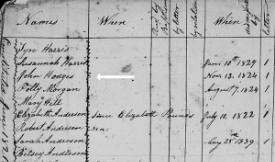
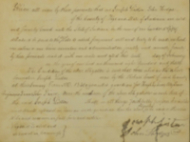
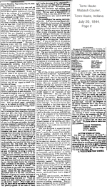
 John Hodges is said to have died on May 17, 1856, in Vigo County. This seems plausible as his wife Ally was given guardianship of their only underaged child on May 21, 1856. It is believed John Hodges was buried in the Mt. Pleasant Cemetery (pictured) in Terre Haute with his wife. There is illegible writing on the north side of her stone. The writing is much older than Allie's or her daughter and son-in-law Sarah and George Sparks, who share the stone with her. It is believed that this may also be John's gravesite. At the time he died, the church was on the same side of the road as the cemetery and his stone would have faced the church. John and Allie were living in that area at the time and their former preacher was preaching at Mt. Pleasant Church. All early cemetery records of this cemetery were destroyed in a fire in a cemetery outbuilding many years ago so this theory cannot be officially proved. There are no other burial records for John Hodges in or near Vigo County, Indiana to dispute this.
John Hodges is said to have died on May 17, 1856, in Vigo County. This seems plausible as his wife Ally was given guardianship of their only underaged child on May 21, 1856. It is believed John Hodges was buried in the Mt. Pleasant Cemetery (pictured) in Terre Haute with his wife. There is illegible writing on the north side of her stone. The writing is much older than Allie's or her daughter and son-in-law Sarah and George Sparks, who share the stone with her. It is believed that this may also be John's gravesite. At the time he died, the church was on the same side of the road as the cemetery and his stone would have faced the church. John and Allie were living in that area at the time and their former preacher was preaching at Mt. Pleasant Church. All early cemetery records of this cemetery were destroyed in a fire in a cemetery outbuilding many years ago so this theory cannot be officially proved. There are no other burial records for John Hodges in or near Vigo County, Indiana to dispute this.
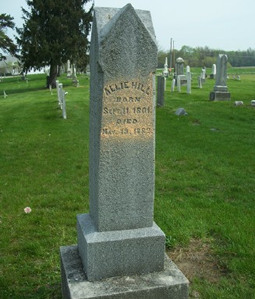 On February 28, 1863, she was released from the guardianship because her son John M. had died in 1858. She signed all the guardianship papers as Ally Hodges. In 1860 her son Hardin and daughter Mary Ann both died. Three years later she married Hardy Hill, a widower of Sullivan County, Indiana. The May 7, 1870, Constituent Membership Record of the Shelburn Baptist Church, which was established one mile from the Little Flock Church, by previously dismissed members of Little Flock, lists Hardy Hill Jr. as the second member with Mary listed as his first wife and Ally Siner Hodges, widow of John Hodges and daughter of Benjamin Siner, as his second wife. It seems that the Hill family pioneered Curry's Prairie, Currysville, the town of Shelburn, and establishment of Little Flock Church, which was absorbed into the Shelburn Baptist Church-all in Sullivan County, IN.
On February 28, 1863, she was released from the guardianship because her son John M. had died in 1858. She signed all the guardianship papers as Ally Hodges. In 1860 her son Hardin and daughter Mary Ann both died. Three years later she married Hardy Hill, a widower of Sullivan County, Indiana. The May 7, 1870, Constituent Membership Record of the Shelburn Baptist Church, which was established one mile from the Little Flock Church, by previously dismissed members of Little Flock, lists Hardy Hill Jr. as the second member with Mary listed as his first wife and Ally Siner Hodges, widow of John Hodges and daughter of Benjamin Siner, as his second wife. It seems that the Hill family pioneered Curry's Prairie, Currysville, the town of Shelburn, and establishment of Little Flock Church, which was absorbed into the Shelburn Baptist Church-all in Sullivan County, IN. 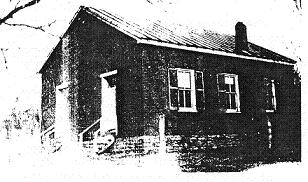 detailed record of Births, Marriages & Deaths ... as kept by the Rev. William Douglas 1750-1797. His baptism was held in the St James Northam Parish there.
detailed record of Births, Marriages & Deaths ... as kept by the Rev. William Douglas 1750-1797. His baptism was held in the St James Northam Parish there.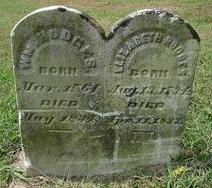 Elizabeth in 1815 – eight children in all. They lived on 70 acres of his father-in-law’s land. The 1830 census records them as still living in Boone County. This census has several Neals and Hodges living near by.
Elizabeth in 1815 – eight children in all. They lived on 70 acres of his father-in-law’s land. The 1830 census records them as still living in Boone County. This census has several Neals and Hodges living near by. 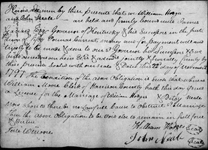
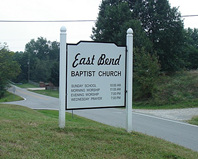 It is interesting to note that their son Andrew worked as a barrel maker in a brewery in Kentucky before being converted and becoming a Baptist minister. He preached at one time at the East Bend Baptist Church, where the family regularly attended services, in Boone County, Kentucky. Since him, there has been at least one Hodges from each generation preach at least one sermon in that same small church.
It is interesting to note that their son Andrew worked as a barrel maker in a brewery in Kentucky before being converted and becoming a Baptist minister. He preached at one time at the East Bend Baptist Church, where the family regularly attended services, in Boone County, Kentucky. Since him, there has been at least one Hodges from each generation preach at least one sermon in that same small church.

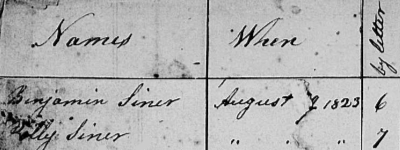
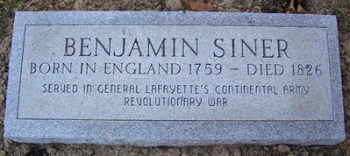 Shortly after making this donation, Benjamin Siner died at about 67 years old, in Evans Prairie in August of 1826 and he was buried in the church cemetery. Unfortunately, there is no mention of Benjamin’s name in the Union Baptist Church records, even though there is a full page for the Deed for the Grave-yard belonging to Union Church in the records. It should be noted that Benjamin’s wife and some of their children are mentioned in the records, so the above land donation statement may very well be true, but never documented.Vigo County historians and family stories state that there was no marker placed at Benjamin's grave, but instead his children planted a Burr Oak seedling at the grave, which grew into a large tree. The tree was cut for its lumber during WWII. The stump, some five or six feet in diameter, was still remaining in 1959 to mark his gravesite.
Shortly after making this donation, Benjamin Siner died at about 67 years old, in Evans Prairie in August of 1826 and he was buried in the church cemetery. Unfortunately, there is no mention of Benjamin’s name in the Union Baptist Church records, even though there is a full page for the Deed for the Grave-yard belonging to Union Church in the records. It should be noted that Benjamin’s wife and some of their children are mentioned in the records, so the above land donation statement may very well be true, but never documented.Vigo County historians and family stories state that there was no marker placed at Benjamin's grave, but instead his children planted a Burr Oak seedling at the grave, which grew into a large tree. The tree was cut for its lumber during WWII. The stump, some five or six feet in diameter, was still remaining in 1959 to mark his gravesite. 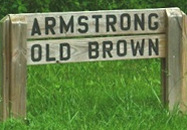 Pictures were taken in 1959 to document the tree stump. Due to the move of the church building, the cemetery later became known as Brown Cemetery and currently is called Old Brown Cemetery and is located in Blackhawk, Vigo County Indiana. Sometime in the recent past, a modern stone marker (mouse over grave marker photo) was placed for Benjamin Siner at his gravesite. This cemetery is now also known as the Armstrong Cemetery and the Union Baptist Cemetery (mouse over sign photo). The stone reads: Served in General Lafayette's Continental Army Revolutionary War.
Pictures were taken in 1959 to document the tree stump. Due to the move of the church building, the cemetery later became known as Brown Cemetery and currently is called Old Brown Cemetery and is located in Blackhawk, Vigo County Indiana. Sometime in the recent past, a modern stone marker (mouse over grave marker photo) was placed for Benjamin Siner at his gravesite. This cemetery is now also known as the Armstrong Cemetery and the Union Baptist Cemetery (mouse over sign photo). The stone reads: Served in General Lafayette's Continental Army Revolutionary War. 
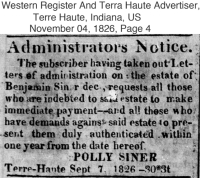
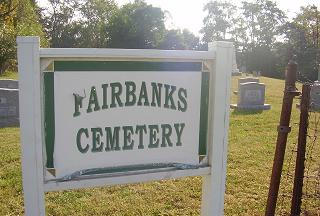 On the reverse of this summons, the sheriff wrote, “The within named Polly Siner is not found in my bailiwick.” By this time, Polly Siner was named Polly Harris and was living in Sullivan County. Polly and her second husband Benjamin Harris Sr. were now members of the Prairie Creek Second Baptist Church in Fairbanks Township, Sullivan County, Indiana. It is believed that they never had children.
On the reverse of this summons, the sheriff wrote, “The within named Polly Siner is not found in my bailiwick.” By this time, Polly Siner was named Polly Harris and was living in Sullivan County. Polly and her second husband Benjamin Harris Sr. were now members of the Prairie Creek Second Baptist Church in Fairbanks Township, Sullivan County, Indiana. It is believed that they never had children. 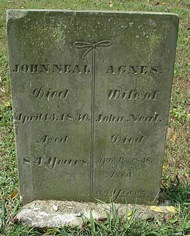 John Neal was born about 1746. Some researchers say it was in the Kentucky Territory which was then Virginia, to John Neal Sr. and Elizabeth Porter. Others say he was born in Lancaster County, Pennsylvania, the son of John Owen Neel and his wife Dorcas Michael and after his mother’s death, he made his way to the Kentucky Territory with his father and siblings.
John Neal was born about 1746. Some researchers say it was in the Kentucky Territory which was then Virginia, to John Neal Sr. and Elizabeth Porter. Others say he was born in Lancaster County, Pennsylvania, the son of John Owen Neel and his wife Dorcas Michael and after his mother’s death, he made his way to the Kentucky Territory with his father and siblings. 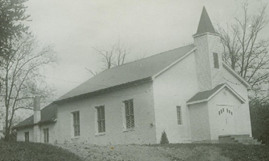 John’s wife Agnes died in 1782 and John married 26-year old Agnes Midkiff on May 24, 1782 in Pittsylvania, Virginia. They had four additional children – John Jr on December 22, 1786; Sarah about 1787; Thomas in 1792; and Anna in 1796 in the newly formed (1792) state of Kentucky.
John’s wife Agnes died in 1782 and John married 26-year old Agnes Midkiff on May 24, 1782 in Pittsylvania, Virginia. They had four additional children – John Jr on December 22, 1786; Sarah about 1787; Thomas in 1792; and Anna in 1796 in the newly formed (1792) state of Kentucky. 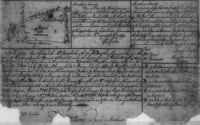
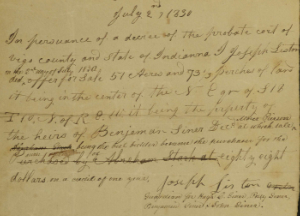

 homas married Christian, whose maiden name is unknown, about 1705 and they had seven children together, some bearing the names of the above mention immigrants. (See Christian’s bio for more on this.) They spent their early married years in Goochland County. In 1740 they lived in what is now Cumberland County, Virginia. Cumberland County was formed from the section of Goochland County that lay south of the James River in 1749. They lived on 550 acres among the south branches of the Willis River. There is a 1746 record that Thomas owned 400 of acres on Willis River in Patent Book 24 in the Archives of Virginia State Library in Richmond.
homas married Christian, whose maiden name is unknown, about 1705 and they had seven children together, some bearing the names of the above mention immigrants. (See Christian’s bio for more on this.) They spent their early married years in Goochland County. In 1740 they lived in what is now Cumberland County, Virginia. Cumberland County was formed from the section of Goochland County that lay south of the James River in 1749. They lived on 550 acres among the south branches of the Willis River. There is a 1746 record that Thomas owned 400 of acres on Willis River in Patent Book 24 in the Archives of Virginia State Library in Richmond.